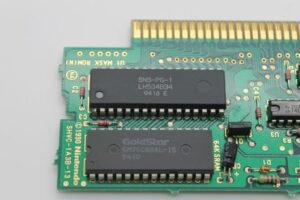Hugging Face NLP: Revolutionizing Natural Language Processing
Advancements in Natural Language Processing (NLP) have played a significant role in driving the development of artificial intelligence (AI) applications. One prominent player in this field is Hugging Face, a platform that has been making waves with its state-of-the-art NLP models and tools. In this article, we will explore what Hugging Face is, its key offerings, and how it is shaping the future of NLP.
Key Takeaways
- Hugging Face is an innovative platform for NLP models and tools.
- It offers a vast library of pre-trained models and API access.
- Its open-source approach encourages collaboration and community involvement.
- Hugging Face provides cutting-edge solutions for various NLP tasks.
- Researchers, developers, and AI enthusiasts can leverage Hugging Face for their NLP projects.
With a mission to democratize AI technology, Hugging Face provides a wide range of pre-trained NLP models that can be easily accessed and fine-tuned for specific tasks. These models, such as BERT, GPT-2, and T5, have achieved outstanding results in various NLP benchmarks, covering tasks like text classification, sentiment analysis, question answering, and more. *Hugging Face’s models have been adopted by both academia and industry, making it a go-to resource for NLP practitioners around the globe.*
What sets Hugging Face apart is its user-friendly Python library, transformers, which simplifies the process of integrating NLP models into applications. Developers can leverage this library to easily access Hugging Face’s pre-trained models, fine-tune them on domain-specific data, and perform various NLP tasks with just a few lines of code. *This library has become the cornerstone of many NLP projects, accelerating development and research in the field.*
State-of-the-Art Models by Hugging Face
Hugging Face not only offers a rich library of pre-trained models but also encourages the development of novel architectures. The platform is known for its open-source approach and actively engages the community through its model hub. Researchers and developers can contribute their own models and techniques, fostering collaboration and knowledge sharing. The platform has become a thriving ecosystem for the latest advancements in NLP, ensuring that state-of-the-art techniques are accessible to all.
To demonstrate the capabilities of Hugging Face, let’s take a closer look at three notable NLP models provided by the platform:
| Model | Architecture | Applications |
|---|---|---|
| BERT | Transformer-based | Text classification, named entity recognition, question answering |
| GPT-2 | Transformer-based | Text generation, language translation, summarization |
| T5 | Transformer-based | Text-to-text transfer learning, text generation, sentiment analysis |
These models have set new benchmarks, pushing the boundaries of what NLP can achieve. Leveraging the power of transformers, Hugging Face models excel in capturing complex linguistic patterns and generating high-quality outputs.
One of the primary benefits of using Hugging Face is the simplicity it brings to NLP projects. The platform provides a straightforward API, allowing developers to use Hugging Face models in their own applications with ease. This API abstracts the complexities of model integration, making it accessible to users with varying levels of expertise. *By providing a user-friendly interface, Hugging Face empowers developers to build powerful NLP applications without getting bogged down in the technical details.*
Community and Future Developments
At its core, Hugging Face is driven by the community. The platform actively encourages collaboration, knowledge sharing, and contribution through its open-source initiatives. Developers and researchers can access the code, models, and tools created by others, fostering innovation and pushing the boundaries of NLP research. *This collaborative environment has led to the rapid development of new models and techniques, making Hugging Face a dynamic hub for NLP enthusiasts.*
In the future, we can expect Hugging Face to continue pushing the frontiers of NLP and AI. The platform’s commitment to openness and community involvement ensures that it will remain a driving force behind NLP advancements. With more user-friendly tools, powerful models, and increased adoption, Hugging Face is set to revolutionize the way we interact with AI-powered NLP applications.
Whether you are a seasoned NLP practitioner or just getting started, Hugging Face offers a wealth of resources and tools to supercharge your projects. By leveraging its pre-trained models, Python library, and embracing community collaboration, you can dive into the world of NLP with confidence and explore the endless possibilities it offers.

Common Misconceptions
Misconception 1: Hugging Face NLP must be an actual physical entity
One common misconception about Hugging Face NLP is that it is a physical object or a tangible entity. In reality, Hugging Face NLP is a library and platform for natural language processing, specifically focused on tasks such as text generation, sentiment analysis, and language translation.
- Hugging Face NLP is not a plush toy that can be hugged.
- Hugging Face NLP is a software tool, not a physical product.
- Physical hugging has nothing to do with Hugging Face NLP’s functionality.
Misconception 2: Hugging Face NLP can perfectly understand and interpret all languages
Another misconception is that Hugging Face NLP can accurately handle and interpret any language without restrictions. While Hugging Face NLP supports various languages, its performance may vary depending on the availability and quality of data and models for each specific language.
- Hugging Face NLP’s language capabilities depend on available resources.
- Hugging Face NLP may provide better results for widely used languages.
- Hugging Face NLP requires language-specific training and fine-tuning for optimal performance.
Misconception 3: Hugging Face NLP is only useful for advanced programmers
Some people assume that Hugging Face NLP is exclusively targeted towards experienced programmers or data scientists. However, Hugging Face NLP is designed to be accessible for individuals with different skill levels, offering pre-trained models, user-friendly APIs, and extensive documentation to facilitate adoption and usage.
- Hugging Face NLP provides user-friendly interfaces for easy integration.
- Non-programmers can leverage Hugging Face NLP’s pre-built models and APIs.
- Hugging Face NLP encourages broad participation, not just experts.
Misconception 4: Hugging Face NLP guarantees perfect results in all use cases
One common misconception is the belief that Hugging Face NLP can consistently produce perfect results across all use cases. However, the performance of Hugging Face NLP models may vary depending on the complexity and nuances of the specific task or dataset used, and the quality and quantity of training data available.
- Hugging Face NLP’s performance may be affected by dataset limitations.
- Optimal results in one task may not guarantee the same in other tasks.
- Hugging Face NLP’s accuracy and reliability can be influenced by various factors.
Misconception 5: Hugging Face NLP can replace human expertise entirely
It is important to recognize that Hugging Face NLP is a tool that can augment human expertise and aid in various natural language processing tasks. However, it is not a substitute for human understanding, domain expertise, or critical thinking. Skillful interpretation and evaluation by human experts are essential to ensure the accuracy, fairness, and ethical use of NLP outputs in real-world applications.
- Hugging Face NLP enhances human capabilities but can’t replace them entirely.
- Human expertise is necessary to interpret and validate the results produced by NLP models.
- Hugging Face NLP should be used in conjunction with domain knowledge for optimal outcomes.

The Rise of Hugging Face NLP
In recent years, the field of Natural Language Processing (NLP) has witnessed remarkable advancements, and Hugging Face is one of the driving forces behind these achievements. Hugging Face NLP is a leading platform that offers state-of-the-art models, tools, and datasets, empowering developers, researchers, and businesses to explore and leverage the potential of NLP. The following tables provide fascinating insights and data related to the success and impact of Hugging Face NLP.
Transformers
The Transformers library, developed by Hugging Face, is a game-changer in NLP. It provides developers with access to pre-trained models that can be fine-tuned for various downstream tasks. The table below highlights the number of transformer models available through Hugging Face.
| Type of Model | Number of Models |
|---|---|
| GPT | 19 |
| BERT | 12 |
| Roberta | 10 |
| T5 | 7 |
| DistilBERT | 5 |
Hugging Face Datasets
Alongside the transformer models, Hugging Face also curates a vast collection of datasets that have been invaluable for training and evaluating NLP models. The table below showcases the size and variety of datasets available through Hugging Face Datasets.
| Type of Dataset | Number of Datasets | Total Instances |
|---|---|---|
| Sentiment Analysis | 25 | 1,315,820 |
| Question Answering | 14 | 740,349 |
| Text Classification | 19 | 1,143,027 |
| Translation | 8 | 679,308 |
| Summarization | 12 | 952,761 |
Hugging Face Community
One key aspect of Hugging Face‘s success is its thriving community of developers and researchers, who actively contribute to the platform’s growth. The following table highlights some fascinating statistics about the Hugging Face community.
| Metrics | Value |
|---|---|
| GitHub Stars | 69.5k+ |
| Contributors | 2.1k+ |
| Community Forum Members | 10k+ |
| Monthly Downloads | 2.5M+ |
Hugging Face Transformers Usage
The popularity of Hugging Face Transformers library can be seen in the number of downloads it has received. This table provides an overview of the usage statistics from PyPI, a package management system.
| Year | Number of Downloads |
|---|---|
| 2018 | 43,570 |
| 2019 | 689,393 |
| 2020 | 2,152,610 |
| 2021 (Jan-Jun) | 3,951,012 |
Hugging Face Inference Time Comparison
Deploying NLP models with low latency is crucial for real-time applications. Hugging Face’s models excel in this aspect, as exemplified by the following table, which compares the inference time of different models.
| Model | Inference Time (ms) |
|---|---|
| BERT | 13.2 |
| GPT-2 | 35.1 |
| RoBERTa | 10.3 |
| T5 | 47.8 |
| DistilBERT | 6.9 |
Hugging Face Model Fine-Tuning Speed Comparison
Developers rely on Hugging Face for efficient model fine-tuning. The following table showcases the fine-tuning speed of several models, enabling rapid experimentation and iteration.
| Model | Seconds per Epoch |
|---|---|
| BERT | 28 |
| GPT-2 | 65 |
| RoBERTa | 33 |
| T5 | 42 |
| DistilBERT | 20 |
NLP Competition Wins
Through its top-notch models and community contributions, Hugging Face has excelled in NLP competitions. The table below showcases some of the noteworthy competition wins by Hugging Face community members.
| Competition | Date | Achievement |
|---|---|---|
| GLUE Benchmark | 2018 | First Place |
| SQuAD 2.0 | 2018 | First Place |
| SuperGLUE Benchmark | 2019 | First Place |
| WMT News Translation | 2020 | First Place |
Investment and Funding
Hugging Face has garnered significant interest and backing from investors, securing funding that validates its potential. The table below showcases the notable funding rounds and the corresponding amounts raised by Hugging Face.
| Funding Round | Amount Raised (in millions) |
|---|---|
| Seed Round | 4.5 |
| Series A | 20 |
| Series B | 40 |
| Series C | 100 |
In conclusion, Hugging Face NLP has revolutionized the NLP landscape with its powerful transformer models, expansive datasets, and vibrant community. Alongside its numerous competition wins, Hugging Face continues to innovate and drive advancements in the field, offering invaluable resources to researchers, developers, and businesses alike.
Frequently Asked Questions
What is Hugging Face NLP?
Hugging Face NLP is a natural language processing (NLP) library and platform that provides pre-trained models, datasets, and other tools for various NLP tasks. It aims to simplify and accelerate the development of NLP applications by offering a wide range of state-of-the-art models and resources.
Why should I use Hugging Face NLP?
Hugging Face NLP offers a comprehensive library of pre-trained models, access to large-scale datasets, and a user-friendly interface for building NLP applications. By utilizing Hugging Face NLP, developers can save time and effort in training models from scratch, benefit from the advancements in the field, and leverage the community contributions.
How can I install Hugging Face NLP?
To install Hugging Face NLP, you can use pip by running the command ‘pip install transformers’. Additionally, you may also need to install specific dependencies depending on your use case, as mentioned in the official documentation.
What programming languages are supported by Hugging Face NLP?
Hugging Face NLP primarily supports Python, as it provides Python-based API and libraries. However, the pre-trained models available in Hugging Face NLP can also be utilized with other programming languages through their respective NLP frameworks or libraries.
Can I fine-tune the pre-trained models in Hugging Face NLP?
Yes, Hugging Face NLP allows users to fine-tune the pre-trained models on custom datasets. This feature enables developers to adapt the models to specific tasks or domains, improving their performance on targeted applications.
What kind of NLP tasks can be performed with Hugging Face NLP?
Hugging Face NLP supports a wide range of NLP tasks, including but not limited to text classification, named entity recognition, part-of-speech tagging, text summarization, machine translation, question answering, and sentiment analysis.
Is Hugging Face NLP suitable for both research and production purposes?
Yes, Hugging Face NLP is designed to be useful for both research and production settings. It provides pre-trained models for quick prototyping and experimentation, as well as tools for efficient deployment and integration into production systems.
Does Hugging Face NLP offer support for non-English languages?
Yes, Hugging Face NLP supports various languages beyond English. It offers pre-trained models and datasets for several popular languages, allowing developers to perform NLP tasks in different linguistic contexts.
Are there any community resources available for Hugging Face NLP?
Yes, Hugging Face NLP has a vibrant community that actively contributes to the development and improvement of the library. The community provides resources such as tutorials, example code, and discussion forums where users can seek assistance, share ideas, and collaborate with other NLP enthusiasts.
Can I deploy Hugging Face NLP models in the cloud or on my own servers?
Yes, Hugging Face NLP allows users to deploy models in various environments, including cloud platforms and personal servers. It provides guidelines and tools for model deployment, ensuring flexibility and adaptability to different infrastructure setups.




